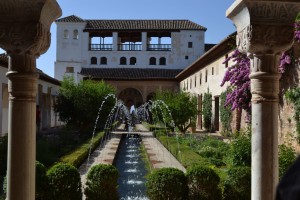
I spent several weeks one summer in the Andalucía region of Spain. My trip included Granada, Seville, Cádiz, Córdoba, Madrid, Toledo, Segovia, and a few other cities. While the weather—particularly the mid-afternoon—was sweltering, one thing I did look forward to was trying the sangria at the many tapas restaurants we frequented. I found that most sangrias were made from fresh fruit (usually peaches, oranges, limes, and sometimes lemons or apples), red wine, brandy, and (sometimes) seltzer or a similar carbonated liquid. It was certainly a refreshing way to sit down after spending a day under the scorching sun and each restaurateur seemed to have a different way of making the traditional fruity beverage. Despite touring many cities that summer, Granada probably remains at the top of my list for Spain. Granada itself is a beautiful city known for its gratis tapas and tasty sangria, and is quite a different aesthetic from that of the streets of either Madrid or Seville.

In recent news, the European Parliament passed legislation that imposes stricter geographical labeling rules for Sangria. In particular, the European legislation attests that “real” Sangria comes from Spain and Portugal. See True Sangria Wine Comes from Spain, Portugal; see also ABC News: True Sangria Wine Comes from Spain, Portugal. Going forward, aromatized wines from other European countries will need to include country of origin labeling. “European lawmakers in Strasbourg passed the motion—which also protects the Vermouth and Gluehwein aromatized wines—in a 609-72 plenary vote with four abstentions.” True Sangria Wine Comes from Spain. The new legislation is still awaiting a “rubber stamp” from European Union governments. Id.
The legislation had an overwhelming 90% of the Parliament’s votes in favor of restricting Sangria to Spain and Portugal unless the product includes a designated country of origin label. See It’s Only ‘Sangria’ if it Comes from Iberia. I am yet to see the exact legislation, but according to the European Parliament website, both the fruit and the wine must come from Spain or Portugal to be labeled “sangria” (i.e., without the designated country of origin labeling). See Things We Learnt in Plenary: EU Presidency, Greener Vans, Public Procurement. The legislation also applies to clarea, or sangria blanca, the white wine version of the traditional red wine beverage. See Off Limits: EU Bans ‘Foreign-Made’ Sangria.
What is interesting to consider is whether the addition of fruit produced only in Spain or Portugal has been the tradition of Spanish and Portuguese sangria producers. Council Regulation (EEC) No 1601/91 from June 1, 1991 suggests that, at least with respect to European Union law, sangria is
a drink obtained from wine, aromatized with the addition of natural citrus-fruit extracts or essences, with or without the juice of such fruit and with the possible addition of spices, sweetened and with CO2 added, having an acquired alcoholic strength by volume of less than 12 % vol. The drink may contain solid particles of citrus-fruit pulp or peel and its colour must come exclusively from the raw materials used. The description ‘Sangria’ must be accompanied by the words ‘produced in . . .’ followed by the name of the Member State of production or of a more restricted region except where the product is produced in Spain or Portugal. The description ‘Sangria’ may replace the description ‘aromatized wine-based drink’ only where the drink is manufactured in Spain or Portugal. Council Regulation (EEC) No 1601/91 of 10 June 1991.
The above definition of sangria under European Union law is from a 1991 Council Regulation, however the Regulation does not directly comment on whether the fruit used in Spanish and Portuguese sangria must be of Spanish or Portuguese origin. Perhaps the Council Regulation suggests such by indicating “the product is produced in Spain or Portugal,” and perhaps there are more restrictive laws or regulations within the countries of Spain and Portugal with respect to the labeling of sangria. From my understanding of geographical indications, it follows through that both the wine and fruit must be of Spanish or Portuguese origin, but from the literal interpretation of the 1991 Regulation, this requirement is not as clear. It will be interesting to review the actual text of the new legislation once it is available from the European Parliament.
Photographs property of Lindsey A. Zahn.
Comments (4)